For the next day, my plan was to go for a walk along the quays of Paris and around the islands – the Ile de la Cite and the Ile Saint Louis. I started from the Place St Michel, went down to the quay by the river and headed upstream.
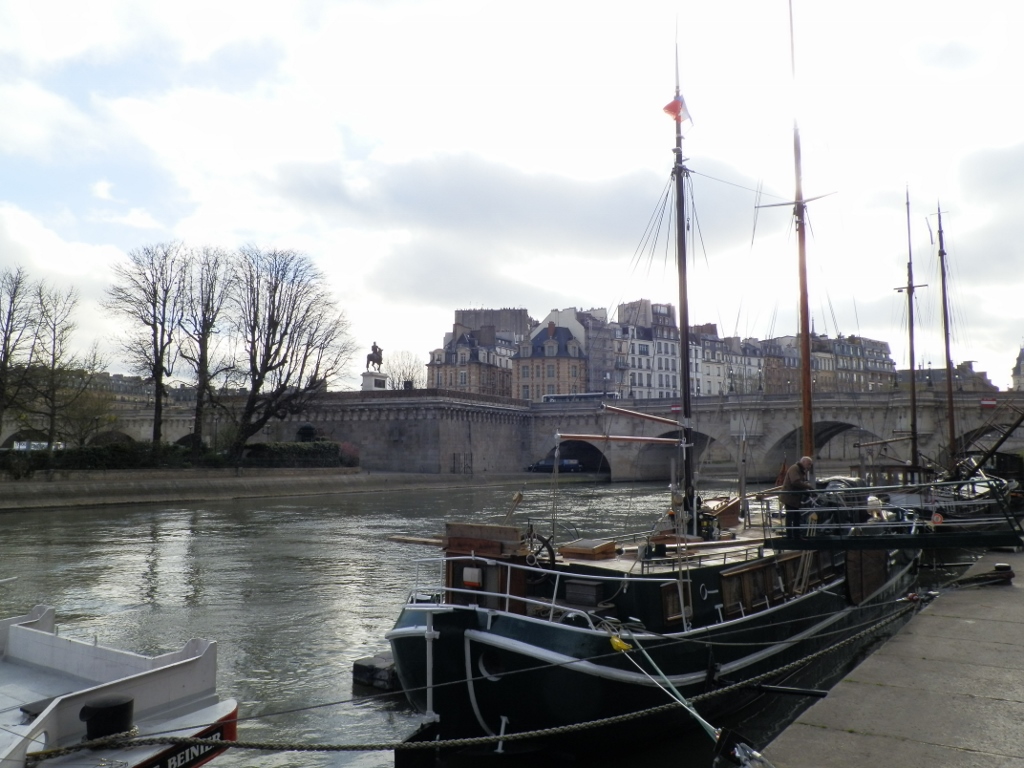 The Seine and the view at the Ile de la Cite and the Pont Neuf
The Seine and the view at the Ile de la Cite and the Pont Neuf
The weather forecast went between cloudy and partially cloudy, and when I opened windows that morning to look at the sky, I could only see greyness. I said to myself it was all right and went out. Still, at some point the clouds started to thin out and as I walked along the left bank towards the Pont Neuf and farther upstream, the sky became blue and the sun started to shine. I was somehow particularly glad about it, because when I imagined my stay in Paris this time, I kept getting the picture of the cathedral of Notre Dame as seen from the Archeveche bridge all dazzling in the sun. And so this really was the case and I was very happy and grateful to the Universe for being so kind to me.
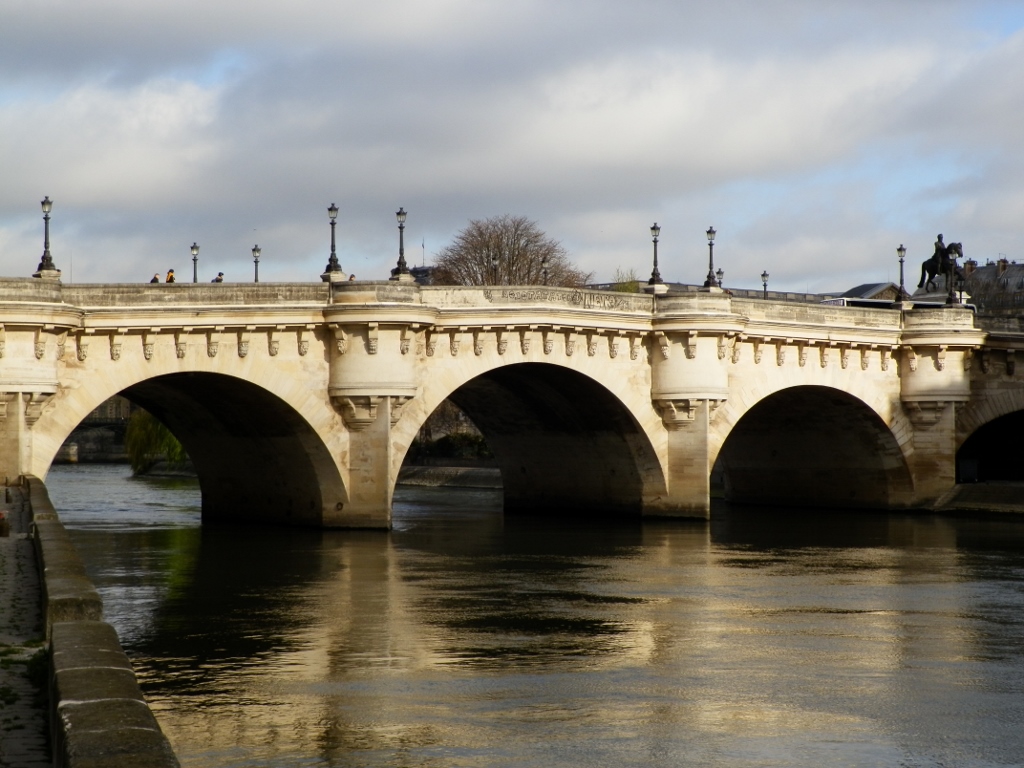 Pont Neuf bridge – the clouds are thinning out
Pont Neuf bridge – the clouds are thinning out
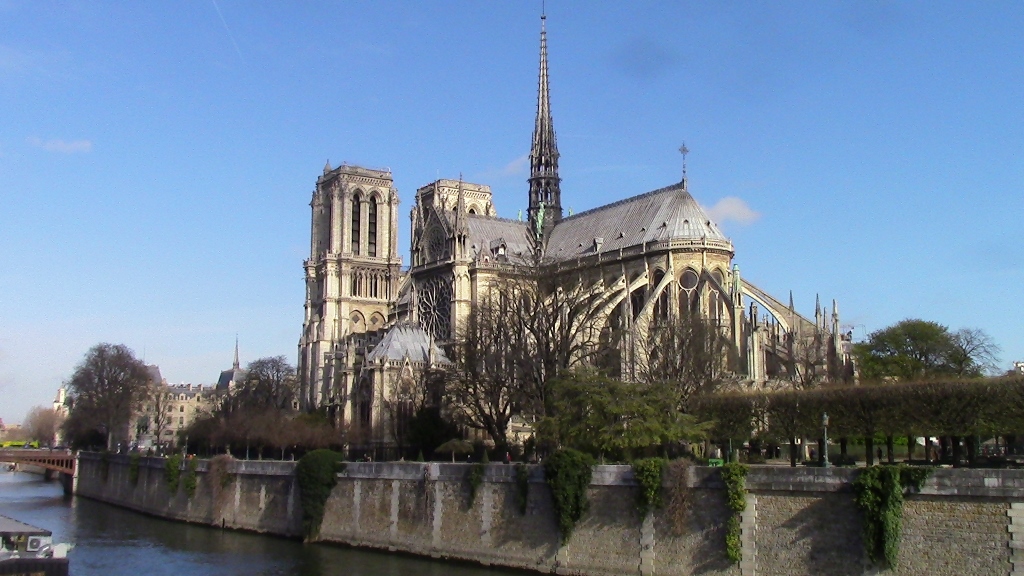 Cathedral of Notre Dame, the picture I was getting in my head prior to the trip
Cathedral of Notre Dame, the picture I was getting in my head prior to the trip
There I stayed for a while taking photos of different details and totals of the Notre Dame church. With the blue skies and the famous edifice, it was easy for one to get inspired.
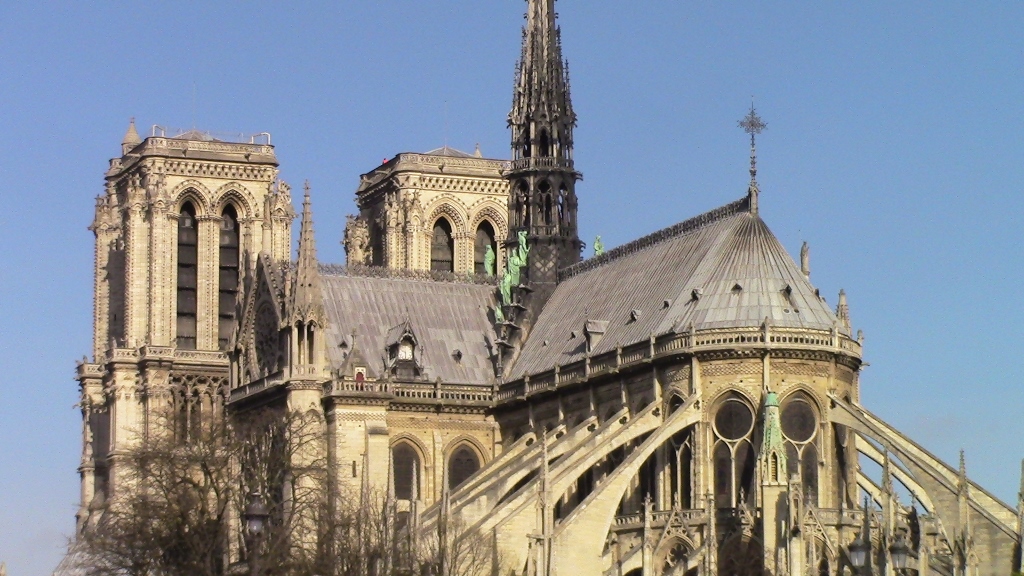 Cathedral of Notre Dame, south-east side
Cathedral of Notre Dame, south-east side
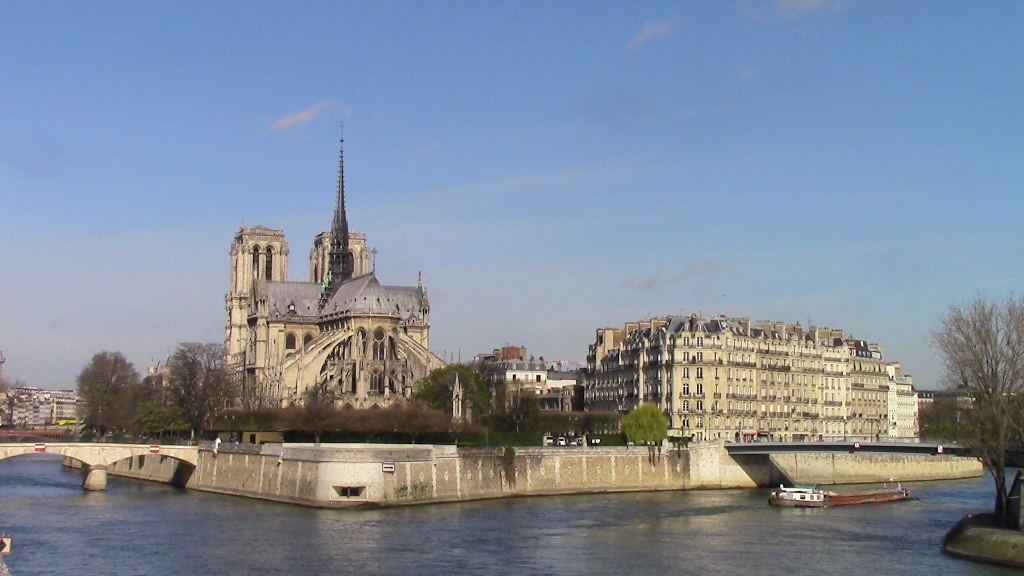 Cathedral of Notre Dame and the top of the Ile de la Cite
Cathedral of Notre Dame and the top of the Ile de la Cite
During my nice walk that led me from one side of the Seine to the other and then a little through some side streets that are not strictly by the river, I mostly followed the route recommended by my 30-year-old guidebook. This is one of the nice aspects of Paris – some things never change. Primarily the distribution of buildings. And yet, I also came across some sights not emphasized by the guidebook which surprised me quite a lot and quite pleasantly. First I caught a sight of the Forney art library situated at the Hotel de Sens which is one of three private medieval palaces that still exist in Paris. It was built at the end of the 15th century and the beginning of the 16th century. At its heyday, the palace was considered to be the most beautiful one and even today it is gorgeous. On one of its sides, there is a small park that belongs to the palace. There, it is possible to see a perfect example of the “French garden.” Namely, as opposed to the “English garden” which entails an apparently free and informal growth of plants, in the French version everything is very clear-cut.
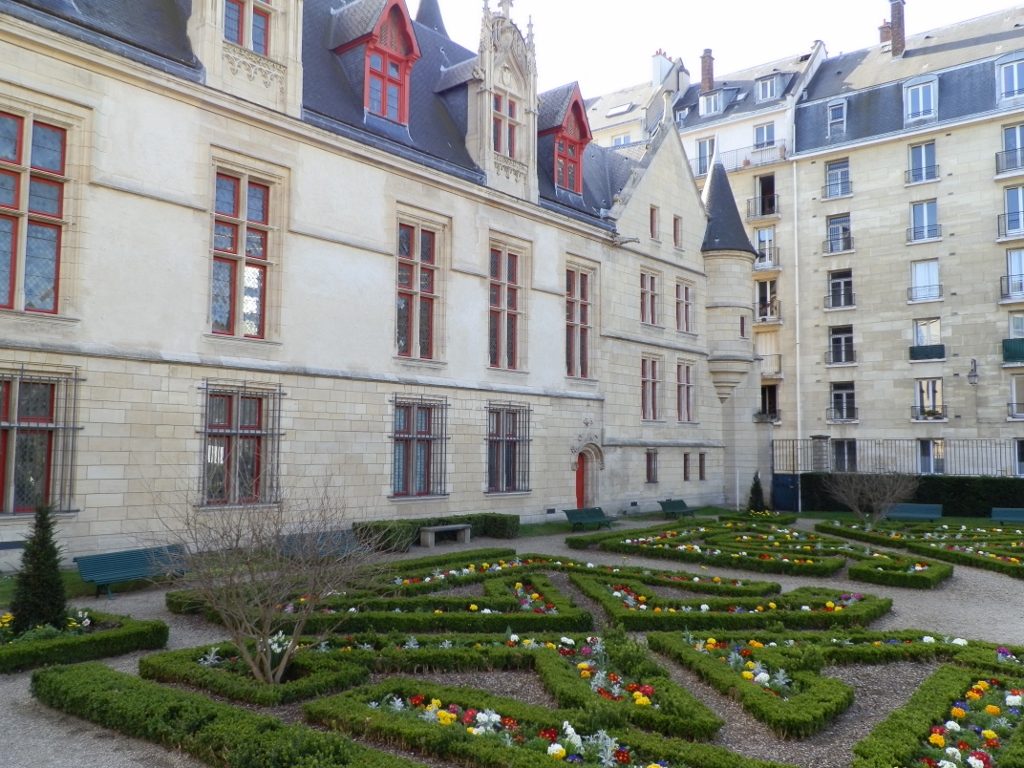 Hotel de Sens garden and palace
Hotel de Sens garden and palace
Another place which I liked very much was a passage behind the church of St-Gervais-St-Protais, dedicated to two Roman officers who died martyrs during the reign of Nero. It is probably even prettier when there is greenery, but this time I had an impression as if looking at some ancient time – I don’t know why, but this place seemed older to me than most of Paris. The church I approached from the back also looked quite pretty and I realized it had a lot of stained glass windows. As the sun was shining unhindered, I hurried up to go inside in order to enjoy the light effects to the fullest. This is obviously not one of the more popular tourist destinations, so the interior was almost devoid of people. What I supposed from the outside was true and the sunlight brought out the beauty of the windows some of which have older motives and some have more recent ones.
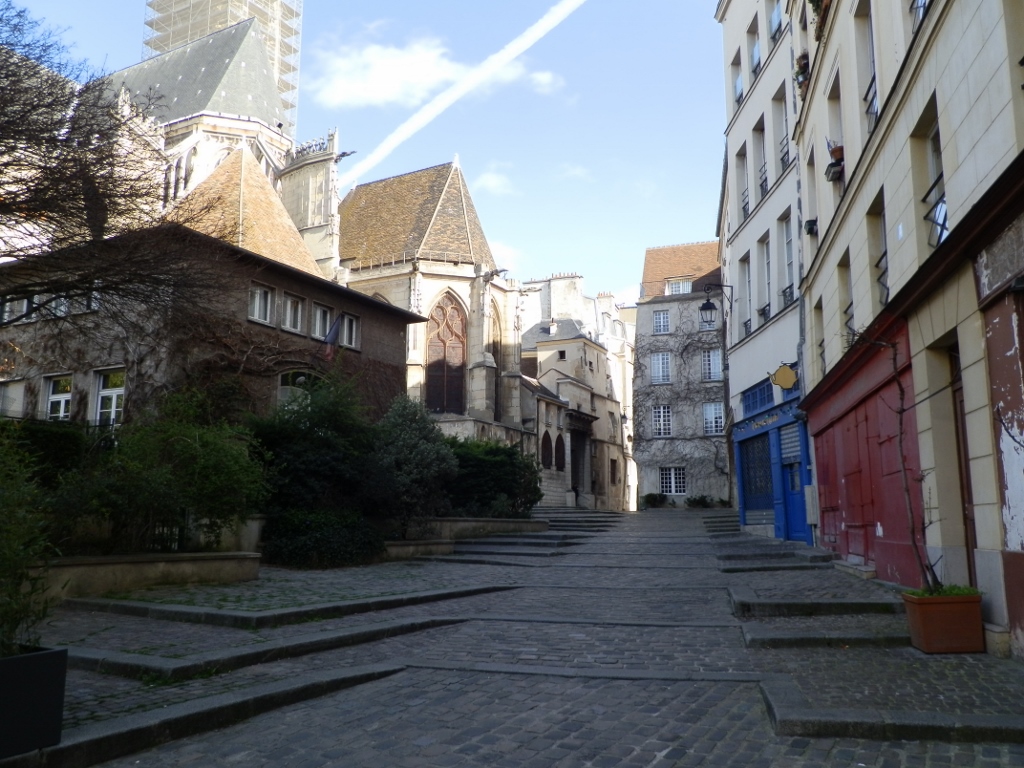 A lane leading to the back of the church of St-Gervais-St-Protais
A lane leading to the back of the church of St-Gervais-St-Protais
As my booked slot for the visit to the Louvre was getting close, I started to weight out if I could see everything I planned before going to the museum, so I also accelerated a little. Thus I went around the Hotel d' Ville, the official seat of the Paris’s city government, and then by the Seine I headed for the Louvre. Along the way I enjoyed some views which I had already seen during the previous days, but under heavy clouds.
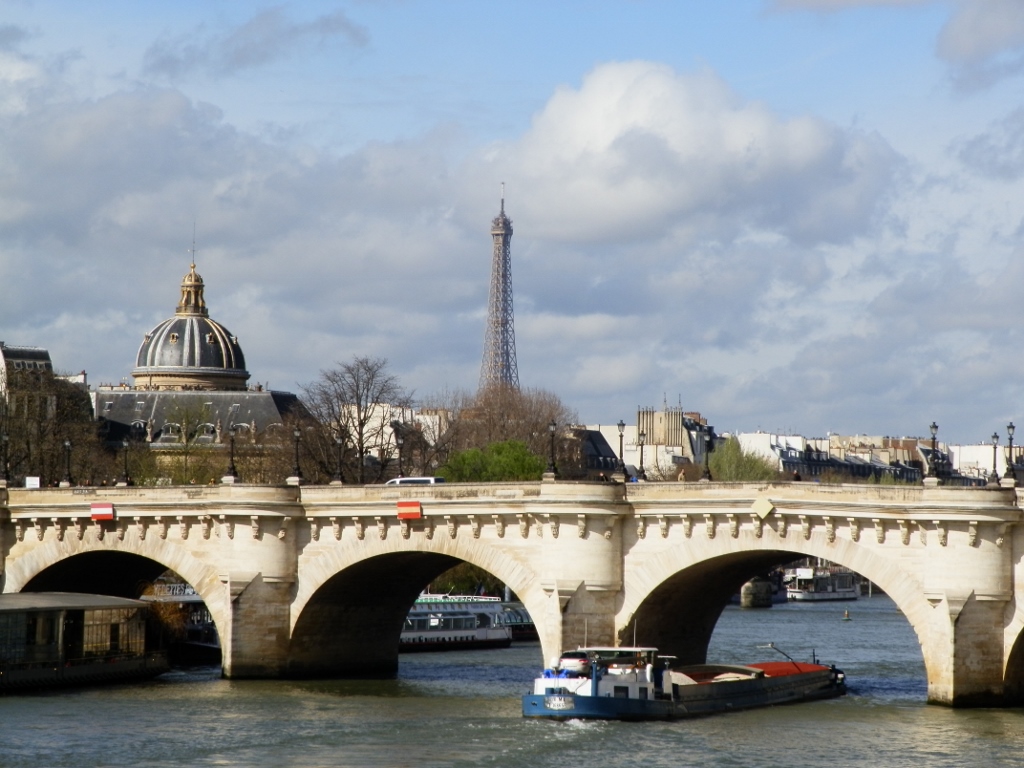 Sun-lit Paris
Sun-lit Paris
Since there are always a lot of people wanting to get into the Louvre I didn’t want to miss my term at any cost. Namely, on this occasion I bought the ticket for the museum while still in Belgrade, through internet. The principle of such purchase is that you book a certain timeslot for entering into the museum. If you miss it, then you have to wait in line as if buying the tickets on the spot. Or something like that. The point was that I wanted to be punctual. Buying the ticket in advance proved to be a great thing. People with printed tickets enter at a specifically designated place and I didn’t wait for more than 5 minutes to get into the glass pyramid, i.e., to the level below, where the central hall is located and from where one can go to the different museum wings. I will not even talk about the length of the line of those who waited to buy the tickets. Still, such an arrangement can also be a bit tricky because, as it happened, I went to the museum when the weather was nice. Before that day, it was constantly cloudy and already in the evening it started to rain with changes between cloudy weather and cloudy weather with rain for the rest of my stay.
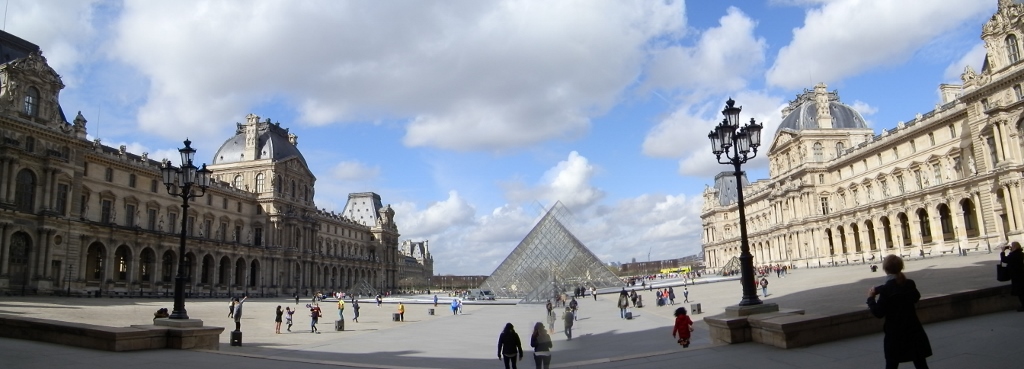 Panoramic picture of the Louvre court (not perfect, but it gets the job done)
Panoramic picture of the Louvre court (not perfect, but it gets the job done)
Do I have to mention that the Louvre is enormous? Of course not, but there are still some details and thoughts on large museums I’d like to share. The Louvre is organized at 4-5 basic levels, with a number of sub-levels, so that there are stairs all over the place and one must get ready to cover huge distances either across flat halls or up and down the stairs. There are a lot of lifts, as the museum really tries to accommodate persons who cannot move with ease (they have a special service that lends wheelchairs), but I still noticed that several lifts were out of order in one section of the museum.
People usually say that it takes several days to visit museums as large as the Louvre. Yes and no. I believe there are four basic concepts of visits. I applied the first one to perfection when I first visited the Louvre. You get prepared, see which of the most important pieces or pieces that you are most interested in are exhibited at the given museum, you find their distribution and then you dash into the museum, “running” from one piece of art you have selected to the next, while throwing superficial glances at the other exhibits you are passing by. This way you stay at the museum for a few hours at the most, while seeing everything you are interested in. Let us not kid ourselves, I think that a vast majority of people do not know much about the history of arts and although truly great pieces of art may “move” us from within even without any prior knowledge, I can’t help thinking that museums are full of phoney people.
The second, more advanced way is to get an audio guide. This has to be paid for separately and it requires that you speak one of the major world languages, but you get valuable information about different oeuvres which can be most enlightening. The third concept is that you come with a group and have a “live” guide who you can also ask a question or two. If you are lucky, you’ll get a descent response. And finally, the fourth way of visiting museums is when you have a lot of time or frequently come to the city where the museum is, and then you go there several times each time visiting ONLY one or two sections at the most, and you look in details everything that belongs to that particular geographic area and to that particular time period to which the exhibits in the given hall belong. But, if you like museums enough to set aside the time and the money for this last version, then there is actually no need for me to be telling you this.
So, these large museums practically consist of several, even a dozen or more reasonably sized museums under one roof. In the case of the Louvre, there is also the detail that this large space has lost its historic function over time, so it was good to fill it up. Now, the museum has grown into an important institution in its own right and there is no way you can size it down.
During this visit to the Louvre, I went again to see a few of the exhibits I hold dear, while everything else I did in passing. I also took time to look out of the windows, for there were some fantastic sights from time to time. Here are a few photos, to enjoy...
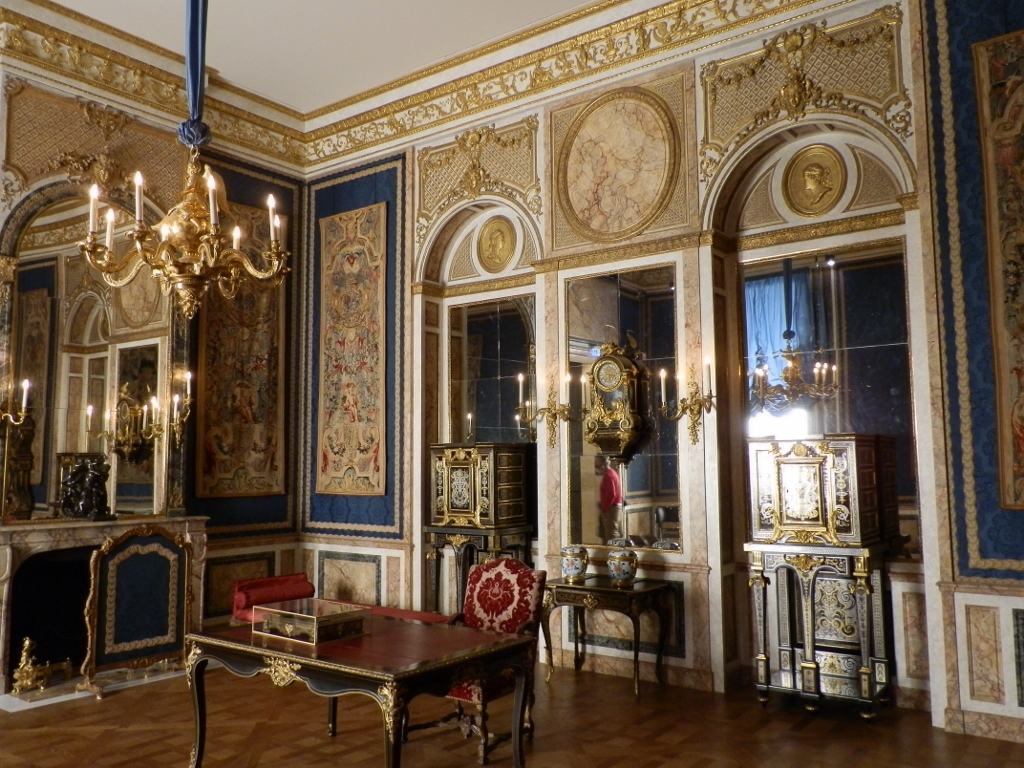 Louvre, Furniture and artistic objects from the period around 1700
Louvre, Furniture and artistic objects from the period around 1700
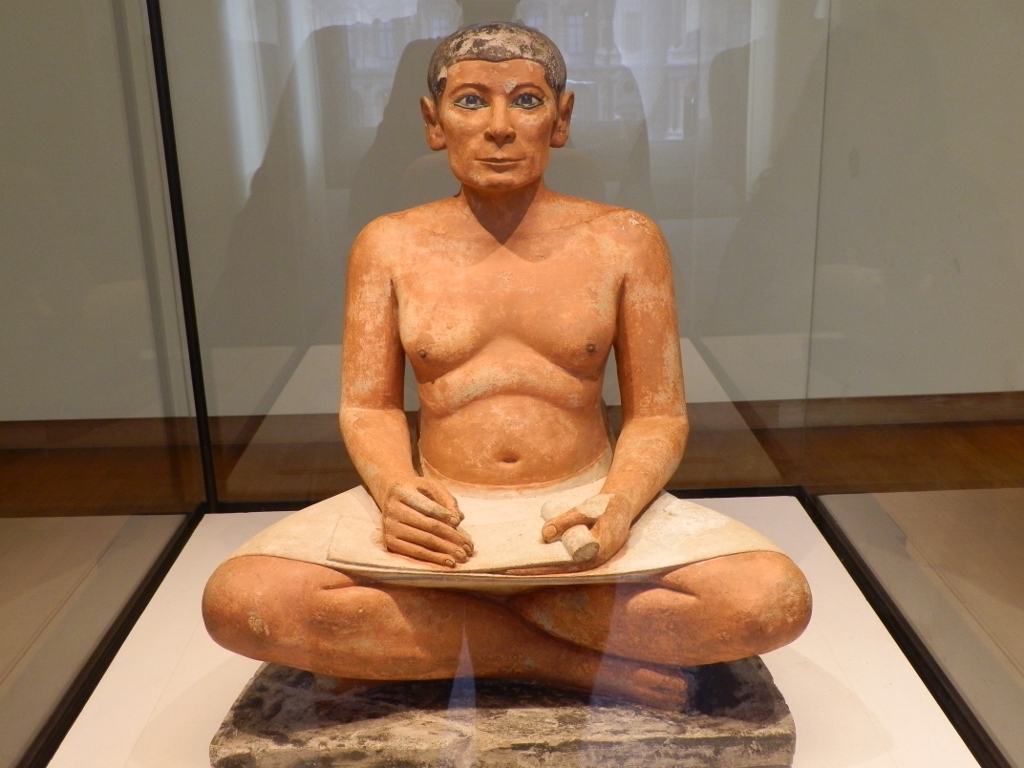 Louvre, Seated Scribe
Louvre, Seated Scribe
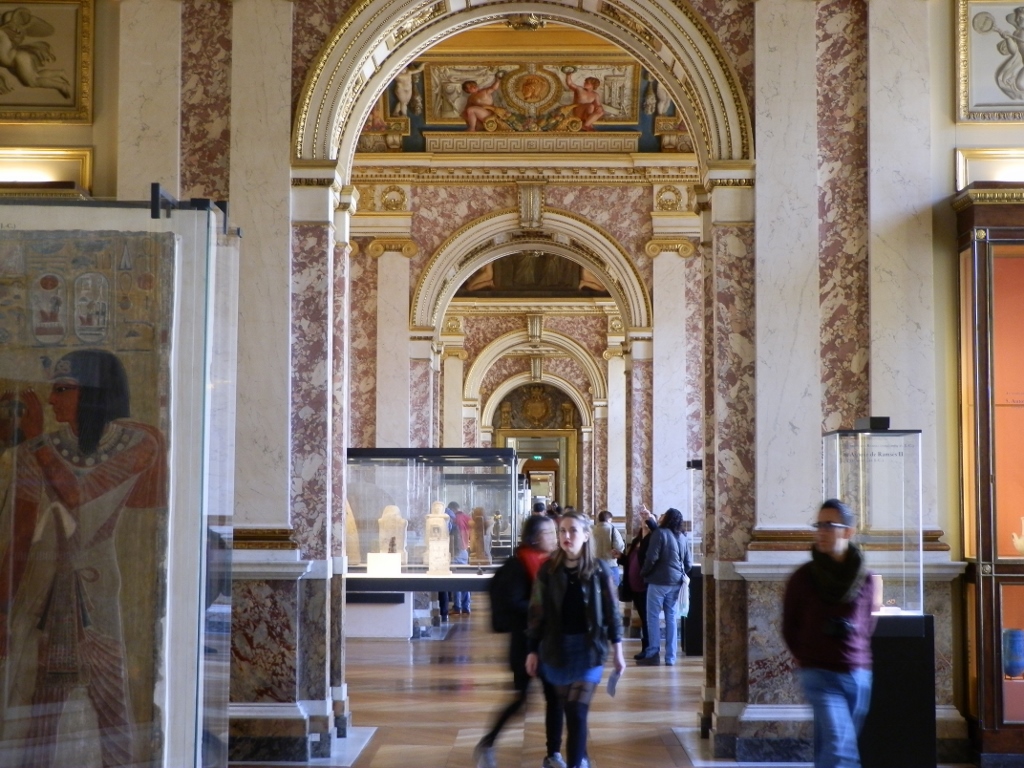 One of the halls at the Louvre
One of the halls at the Louvre
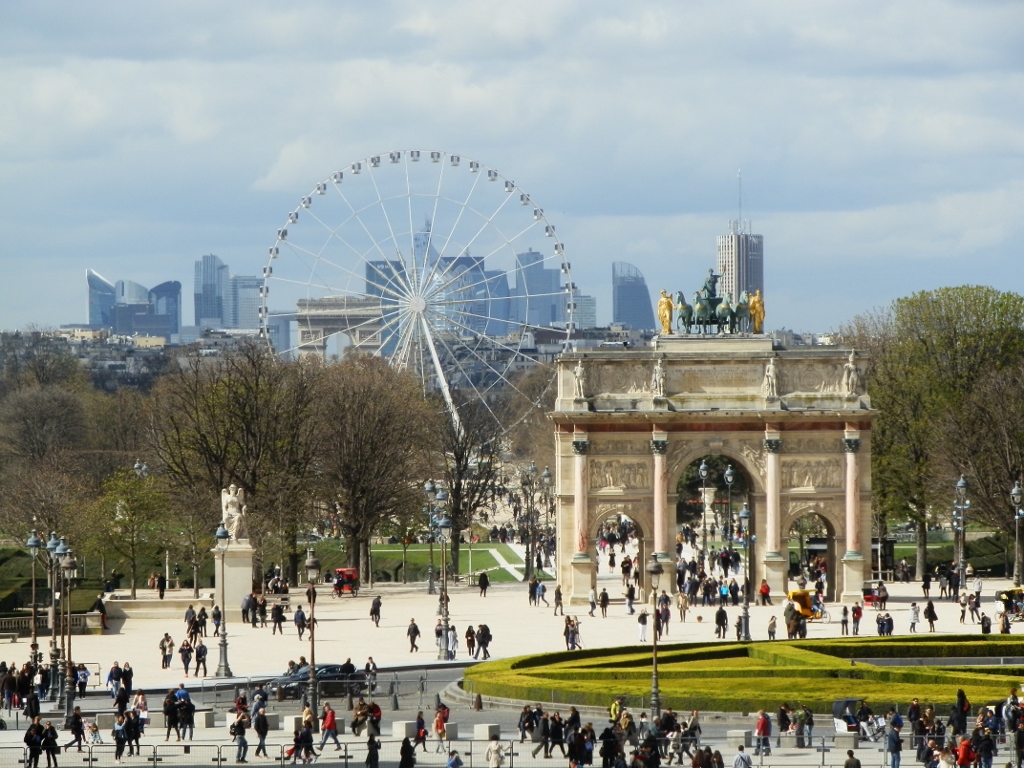 Louvre, view at the Tuileries gardens
Louvre, view at the Tuileries gardens
I was particularly interested in a painting by Leonardo da Vinci which is not Mona Lisa. When I was at the Louvre the last time, it was right there next to Mona Lisa, but this time the most famous Leonardo’s painting was hanging alone on a large wall with a host of people swarming there in order to see it from up close. I first started to panic as to where I would find what I was looking for in the sea of paintings, but then I asked the guards and they directed me to the right place. The painting is the Virgin and Child with Saint Anne.
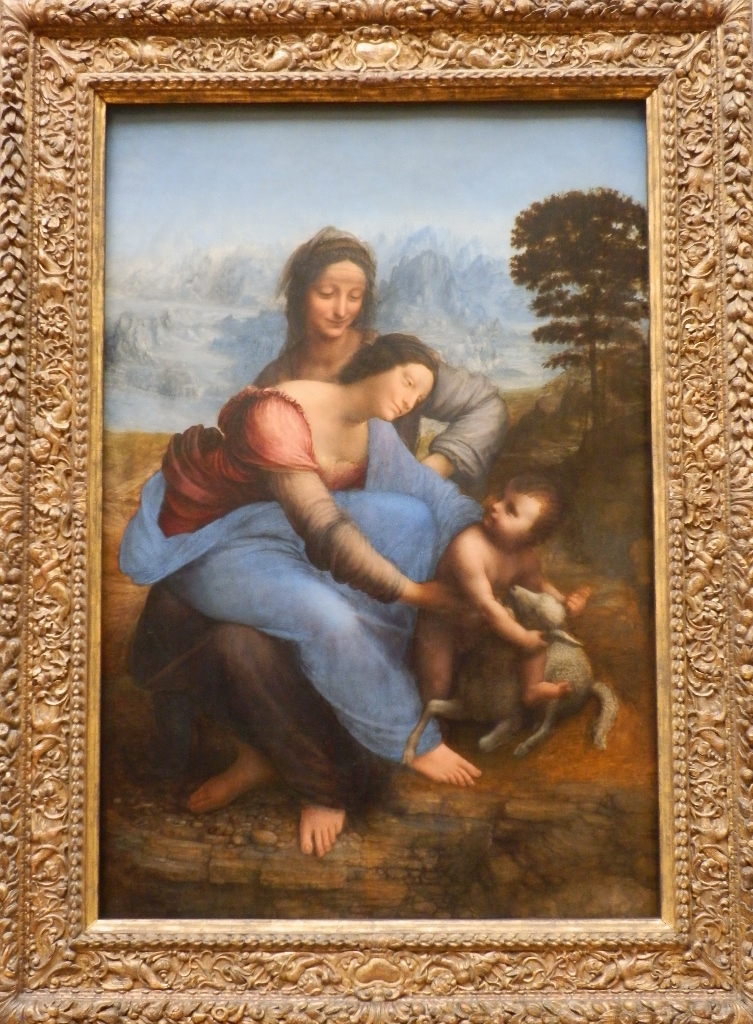 Louvre, Leonardo, the Virgin and Child with Saint Anne
Louvre, Leonardo, the Virgin and Child with Saint Anne
Still, I stayed the longest near the Winged Victory of Samothrace. It is magically beautiful and impressive, and it is even placed on top of a large staircase standing on the fore of a stone boat and as you look at her you cannot help feeling the wind blowing through your hair.
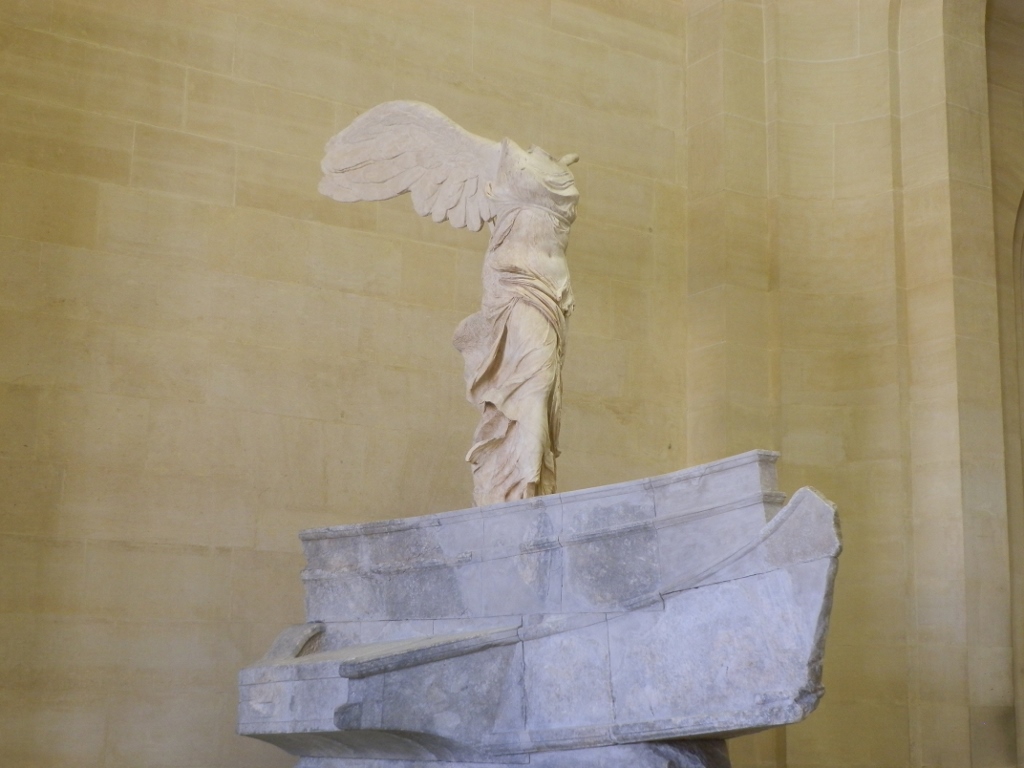 Louvre, Winged Victory of Samothrace
Louvre, Winged Victory of Samothrace
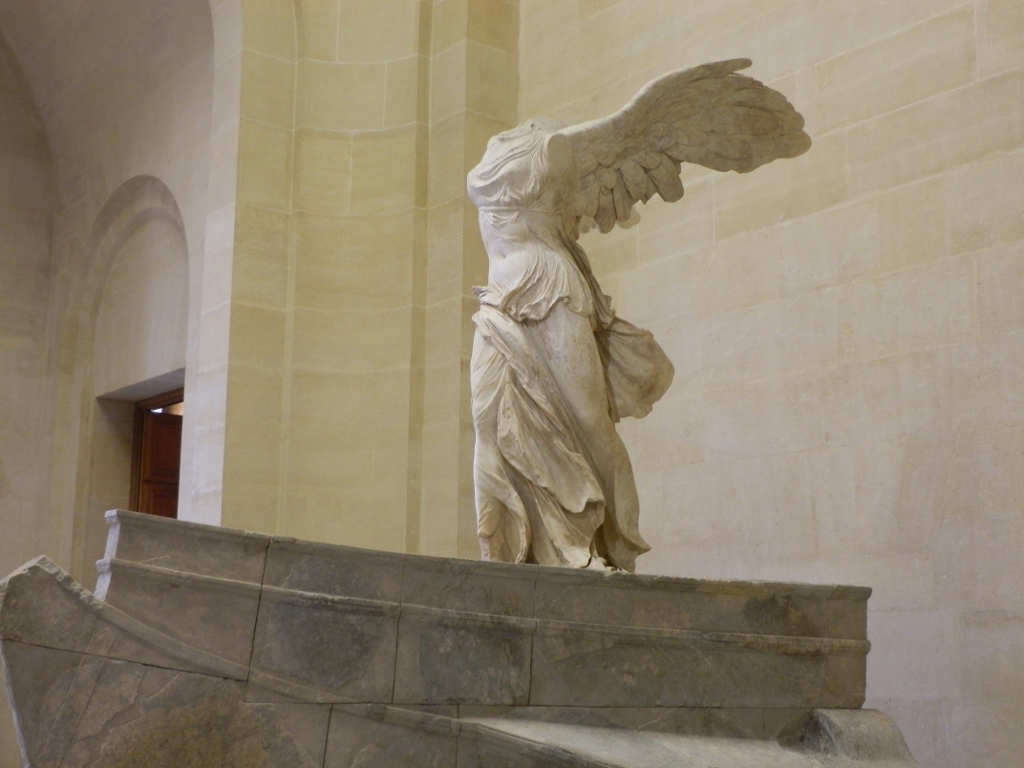 Louvre, Winged Victory of Samothrace
Louvre, Winged Victory of Samothrace
When I bought the ticket for the Louvre, it turned out that at the time of my visit there was a special exhibition of paintings of Vermeer and his contemporaries. I actually didn’t know exactly what I may see there, the poster said Vermeer and the Masters of Genre Painting with a reproduction of Vermeer’s Milkmaid, so I wanted to have a look at that, too. When you buy a ticket for the Louvre, the visit to the special exhibition is free, but you also have to book a timeslot. I did not really think the elements of this visit through, so when getting the tickets online I made a mistake because I didn’t quite get the system. The mistake consisted of the fact that I took two same times, both for visiting the Louvre and for visiting the Vermeer’s exhibit. As I still haven’t mastered the art of existing in two different places as the same time, I first went to the general part of the Louvre. The glass pyramid that was with a lot of controversy built in one of the Louvre courts serves as the entrance into the underground main hall and the security check is done as soon as you enter the pyramid. In the hall there are a couple of cafes and restaurants, the service for wheelchairs, information desk, ticket offices, as well as the place from where you go to the special exhibit.
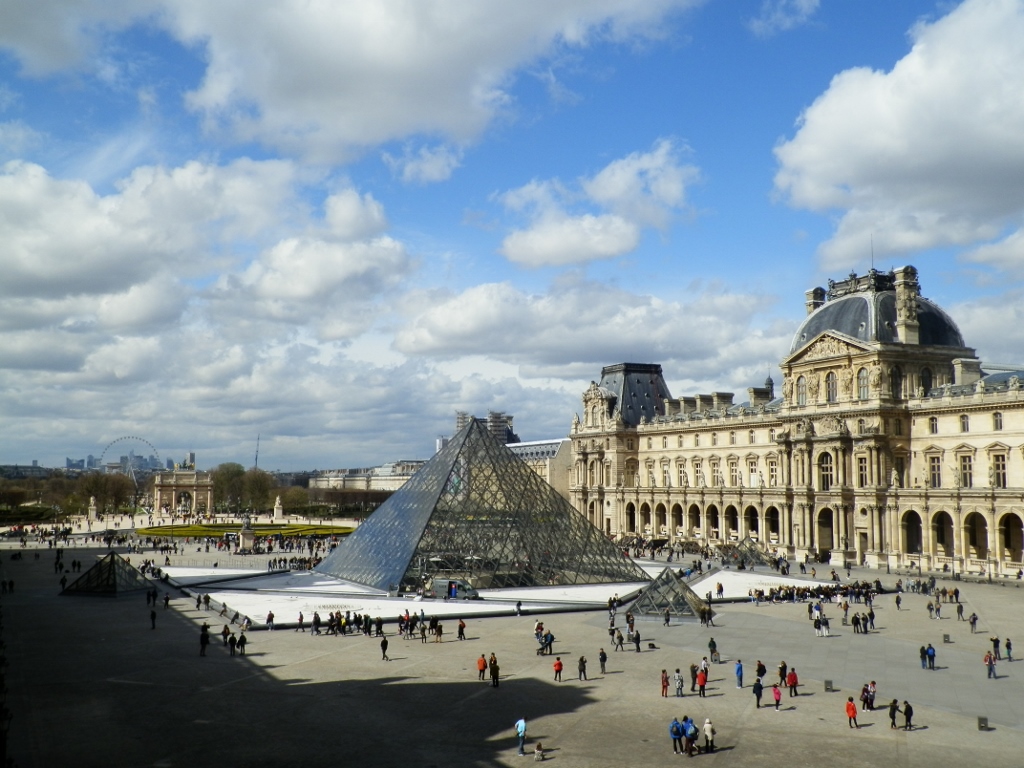 Louvre, the court from which you enter into the museum
Louvre, the court from which you enter into the museum
When I finished with my visit to the main exhibits of the Louvre and wanted to go to the special one, it turned out that my booked timeslot had passed long ago. They referred me to the ticket office, where I waited for a little while, explained my mistake and they gave me an additional ticket with a new timeslot that was 2 hours later!!! I decided to wait. I have to mention that in the meantime I got a nasty blister on the small right toe and thus I had huge problems walking. Hm!? Is it appropriate at such a sublime place when I’m talking about one of the greatest temples of culture to mention something as profane as my right foot and a blister on it? Of course it is! My story, my blister. It is especially appropriate to talk about it when you have to move around that temple, and move a lot, while with each step you see stars that have nothing to do with impressions about the artistic pieces you are surrounded with from all sides. To save you from thinking “well, why didn’t you wear better shoes,” I have to say that I had super comfortable shoes, but I have a particularly sensitive skin on my feet and have always faced the problems with blisters, so that I have rather well developed mechanisms for coping with them, but that doesn’t mean that from time to time I don’t have serious pains. This was such a moment. That’s why I decided to cut the time short by getting something to eat, it was the time for lunch anyway, and I also played some game on my mobile.
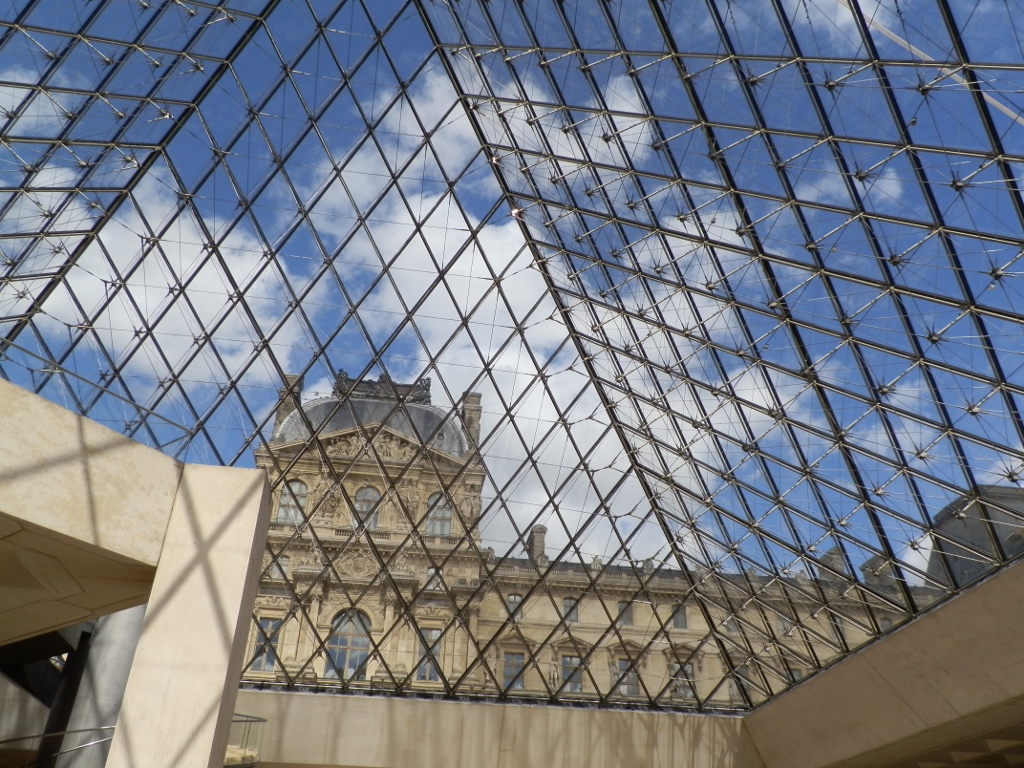 Louvre, view through the pyramid from the museum’s central hall
Louvre, view through the pyramid from the museum’s central hall
Very slowly, but the time did pass eventually. Still, at some moments of doubt, I thought of giving up and simply getting out of there without going to the special exhibit. I thought: “And what if they exhibited only one painting by Vermeer?,” the one that was on the poster. It was actually very good that I didn’t give up, for there were several of Vermeer’s paintings and of course paintings by other authors who are less known to me. It was particularly good that I stayed, for the paintings were borrowed from different museums from around the world. The exhibit included 12 of Vermeer’s paintings and in addition to two which are at the Louvre anyway, there were those coming from Dublin, Washington D.C., Berlin, London, New York, Frankfurt and Amsterdam.
On the other hand, sometimes I still think that such events are not worth the effort. Now the artistically inclined prudes are going to have a heart attack when I give the reason for such a position of mine. Well, all of these pieces can be seen fantastically well either on the internet or in countless books on arts. I know that the afore-mentioned cultural prudes will probably say that some special energy which the artists embedded in their oeuvres oozes from the originals and needs to be experienced. Maybe, even probably or for sure. But... If you are in a group of people who are crowding in order to see some painting better, which you are also trying to do, but is not advisable to push as you may topple somebody, and even when you do come into a good position in relation to the painting you may stay there only for a short while since other people want to see it as well, and they also crowd and try to take their own place, then there is none of that sublime experience of the “original energy.” Maybe there are people who can feel something during those 5 to 6 optimal seconds during which they stand askew or on one leg. I cannot. I need to stay for a little longer, calmly, relaxed, on both legs and if possible without the “energies” of the others who are not the artists, but who are pressed against me.